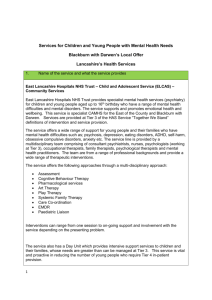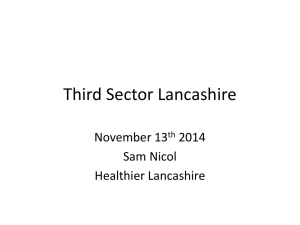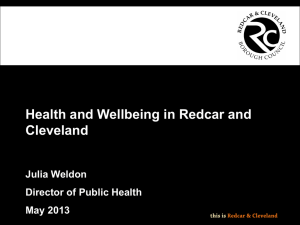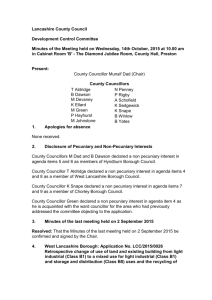here - BWDCVS | Blackburn with Darwen CVS
advertisement
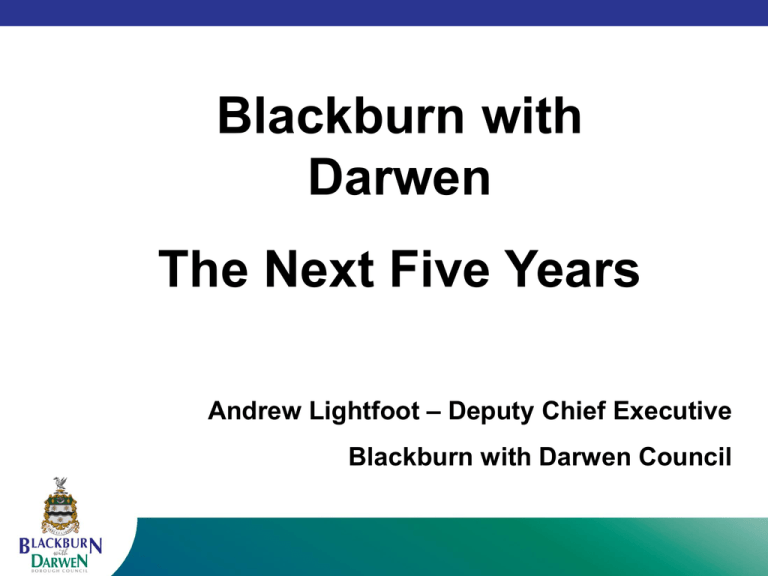
Blackburn with Darwen The Next Five Years Andrew Lightfoot – Deputy Chief Executive Blackburn with Darwen Council A growing population… Pakistani Indian White • population set to grow by 3% by 2021 • biggest growth in the 65+ age group (+17%) A diverse population . . . We’re facing some big challenges But we’re aiming high Creating more jobs and supporting business Our economies The private sector: • 20% employed in manufacturing; 20% distribution and hotels / restaurants; 15% IT and financial services; • Self employment increased over last 3 month period • Lancashire LEP • Pennine Lancashire EDC • 2nd highest borough with ‘Gazelle’ growth companies in the North West The public sector: • Large public sector (32%) with NHS hospital, Unitary Council and FE institutions The third sector: … Over to you … tell your story… employment / volunteering / skills? Creating more jobs and supporting business Our challenges • Employment rate at 61% - below regional and national average • Unemployment levels increasing • (Net) fewer businesses • More redundancies • Pay levels relative decline - Lower earnings (£417pw) than national average (£508pw) • Below average skills levels: – Degree level qualification 22% compared to 33% nationally – 18% of residents have no qualifications compared to 12% nationally Creating more jobs and supporting business Our achievements • £70m investment in Blackburn’s retail core - Mall and new indoor market • Record levels of footfall during the 2011-12 festive period National Indoor Market of the Year 2012. • More than £1.2m of investment in improved public realm in the heart of the town centre • Highest number of small high growth businesses Creating more jobs and supporting business The next five years…… Cathedral Quarter Phase 1, 60 bed hotel; 80,000sq ft office building; Clergy Court (residential New public realm). Onsite commences 2013 , completion mid 2015. £30 million investment Freckleton Street - Strategic employment site earmarked for investment . New link road opens up land for mixed use development. Masterplan developed. Awaiting planning . Pennine Reach Major investment in public transport infrastructure. New bus station - On site 2013 Complete 2016 £6 million investment . European Programme 2014-2020 With a BwD growth strategy underpinned by a business led, major european funding programme in concert with Pennine and Lancashire partnerships Improving housing quality & building more houses Our economies The private sector: • 64% houses owner occupied • 14% houses private rented, doubled since 2001 The public sector: • 18% houses are social housing • 25 known registered social landlords The third sector: • Nightsafe – supported housing for 16-24 year olds (emergency, medium & long term stays) • THOMAS – supported housing and rehabilitation programme for substance misusers Improving housing quality & building more houses Our challenges • Average house prices in Blackburn with Darwen are 42% lower than the North West average, although the trend is consistent with national figures • In the year to July 2013 average house prices fell by 4.0% • In 2012 mortgage repossessions were 50% higher than national rates • Estimated 27,000 properties (over 50%) are non decent and 12,300 with a category 1 hazard • Amongst worst authority areas for fuel poverty – 24% of all households and more than 30% of households in some neighbourhoods Improving housing quality & building more houses Our achievements • £100m of HMR and Council funds during 2001 – 2012. Delivered a range of projects which included: – Over 2,000 homes refurbished and improved – 1,100 unfit & obsolete homes cleared – 700 properties benefited from safety initiatives/environmental improvements – Over 1,000 new including affordable homes delivered which include homes for rent or shared ownership • Regeneration programme attracted around £200m of additional investment from Public/Private sector. Which has contributed to a wide number of initiatives Improving housing quality & building more houses The next five years…… • Only 10% of the housing stock has 4 or more bedrooms compared to a national average of 34% • Only 13% of properties are in Council Tax Band D or above, compared to 21% across the North West • Higher value aspirational and ‘executive’ housing developments will be prioritised • Planning for 600 new homes each year Improving health and wellbeing Our economies The public sector: In 2011/12 we spent £350million on Health and Social Care in the Borough – £15.6m on Health prevention and promotion 4.4% – £70m on primary care 20% – £141m on secondary care 40% – £10m on urgent and emergency care 3.1% – £111m on community health and social care 32% • Of 60,523 working people aged 16-74, 15% or 8,936 work in Health and Social Care • Services are commissioned by Council and CCG along with NHS England • Major providers Lancashire Care NHS Foundation Trust, East Lancashire Hospitals NHS Trust and the Council Private and third sector providers play a vital role Improving health and wellbeing Our challenges • Increasing numbers of older and very old residents • Life expectancy 3 years shorter than nationally and the gap is widening • Half of all adults have one or more long term conditions • Significant increase in alcohol related admissions – trebled over last ten years • Death rate for chronic liver disease has risen and faster than the region or national rate • Smoking rates are high with strong social inequalities • Projected increase in dementia Improving health and wellbeing Our achievements • Year on year increase in life expectancy and decrease in premature deaths • Refresh - introduced first comprehensive free leisure facilities programme for residents to promote physical activity • Continuing strong partnership between local government and health - first with Care Trust Plus and now with the CCG- with nationally significant track-record around integrated commissioning and joint management arrangements • Pioneer for Health and Wellbeing Board - nationally respected • Barbara Castle Way Health Centre - secured £21 million investment in new multi-service health facility in town centre creating 250 new jobs and improving access to services. Improving health and wellbeing The next five years…… Health and Wellbeing Strategy Vision - to increase life expectancy in Blackburn with Darwen, and reduce the gap between Blackburn with Darwen and the national average. Improving outcomes for young people Our economies The private sector: • 44 private/independent nurseries and pre-schools • 1 primary academy and 1 primary free school (from Sept 13) • 2% primary aged children in academies • 2 secondary academies and 1 free school • 22% secondary aged children in academies; 2.5% in free schools The public sector: • 14 children’s centres, 4 Council nursery schools • 14,000+ primary aged children; 9000 secondary & 6,000 16+ learners • 54 primary schools and 7 secondary schools maintained by LA • 2 colleges and 4 6th form colleges The third sector: • 15 voluntary/community/faith nurseries and pre-schools Improving outcomes for young people Our challenges • Increasing school autonomy, flexibility and accountability for children with SEND • Increasing delegation of funding to schools and Council Budget reductions means a changing role for local authorities • Increasing range of service providers • Continued impact of poverty on the children entering schools 3 in 10 children (more than 4 in 10 in some wards) live in poverty • Performance at higher levels of achievement not as strong as at threshold levels Improving outcomes for young people Our achievements • Educational attainment continues to improve and we continue to narrow the gap to national averages – a consistent trend over the past decade. Gap to the national average has narrowed • Primary from 7% to 2% • Secondary from 12% to 1% • Over 80% of children in schools deemed ‘good or better’ by Ofsted • Nearly 90% of young people staying in full time education at 16+ (1% above national average) • 58% of our young people have a level 3 qualification (8% higher than similar authorities and 3% higher than national average) Improving outcomes for young people The next five years…… Our ambitions are to have: • Our children and young people attending schools judged good or better by Ofsted (ideally most to be outstanding!) • Primary and Secondary school performance above national average • Two thirds of local young people entering Higher Education (60% currently) – to maintain the borough’s competitive advantage • More of our children attending the top universities (Russell Group) (6% currently) Safeguarding the most vulnerable people Our economies The private sector: • 24 older people residential and nursing care homes run by companies/organisations The public sector: • 356 children in local authority care; 150 subject to child protection plans and 678 identified as children in need • 4 older people residential and nursing care homes run by the Council The third sector: • Over 130 active foster carer households Safeguarding the most vulnerable people Our challenges • Over 370 investigations for adult safeguarding in 2012/13 • Teenagers are more likely to be frequent consumers of alcohol • Estimated 2,940 residents have a learning disability and of those 930 are 0-25years old (likely to increase 15% in next 10 years) • Approximately 350 children, young people and young adults aged 0-25 will have been diagnosed with complex needs or disability (2013) Safeguarding the most vulnerable people Our achievements • OfSTED - Good children’s services; Good for all aspects of fostering service • Multi-Agency Safeguarding Hub (MASH) established April 2012 more robust approach to identifying vulnerable adults/children • Good and improving recognition of children’s Voice in relation to service design and delivery Safeguarding the most vulnerable people The next five years…… • Integrating health services and social care teams at a local area level, to drive improved outcomes and resource efficiencies • Joint assessment and care planning for children and young people with complex needs, to be rolled out April 2014 • Delivering our Early Help strategy through neighbourhood level early intervention services • Working with our partners in the police to prevent offending and re-offending Making your money go further Our economies The private sector: • £51,346,021.03 (or 35%) spent with businesses and services in BwD in 2012/13 The public sector: • £147m Total spend in 2012/13 The third sector: • £4,835,875 (or 3%) spent with the third sector in 2011/12 Making your money go further Our challenges • Local government finance review – Spending Review 2013 projected further challenges in 2015-16 • Demand management around social care • Partner cuts and the aggregate effects on the borough and residents • Inter-dependency between local economy and local public sector (both employment and spend) Making your money go further Our achievements • Many years of keeping Council tax low • Have achieved our cuts to date • Protected key services that residents have told us they wanted to keep • Innovative partnering arrangements – previous Care Trust Plus; Pennine Lancashire Building Control service; shared neighbourhood teams Making your money go further The next five years…… • Integrated delivery (building on integration track record) across sectors • Continuing to review our assets and make best use of them • New and innovative partnerships – business network; explore further Pennine Lancashire working • More tough decisions on Council role / service coverage and quality Voluntary and Community Sector • A tremendous asset to the borough – under-utilised, recognised and ‘exploited’. • Critical to the maintenance (short-term) and improvement (long-term) of residents’ quality of life. • Central to new models of commissioning and delivery – ‘keep calm and carry on no longer an option’ • Progressive in leading the way with consortia models. • Regionally and nationally significant in its own right – opportunities to collaborate with private and public agencies for the advancement of BwD Voluntary and Community Sector In the spirit of honesty, however, the external view is… • Governance has been introspective and fragmented – at both organisation board and sector level. • Reputation and advocacy has suffered as a result. • Fighting the wrong battles – ‘representation’ and sector balance is no longer on the agenda – focus on impact, delivery and areas of niche sector advantage. • The business model appears to be ‘revving in neutral’ – where are the new income streams, private sector (CSR) partnerships • Is there genuinely a preparedness to innovate and take risks (e.g. new contractual arrangements / PBR?) Voluntary and Community Sector So, in conclusion… • Your organisations are vital to the future of the borough. • You are pushing at an open door around new, innovative partnership, commissioning and delivery arrangements. But it requires… • Clear, coherent, confidence sector leadership and a focus on your ‘core offer’ . • An end to fragmented and confused governance. • A willingness to quickly and genuinely move beyond existing constraints, behaviours and ‘norms’.
